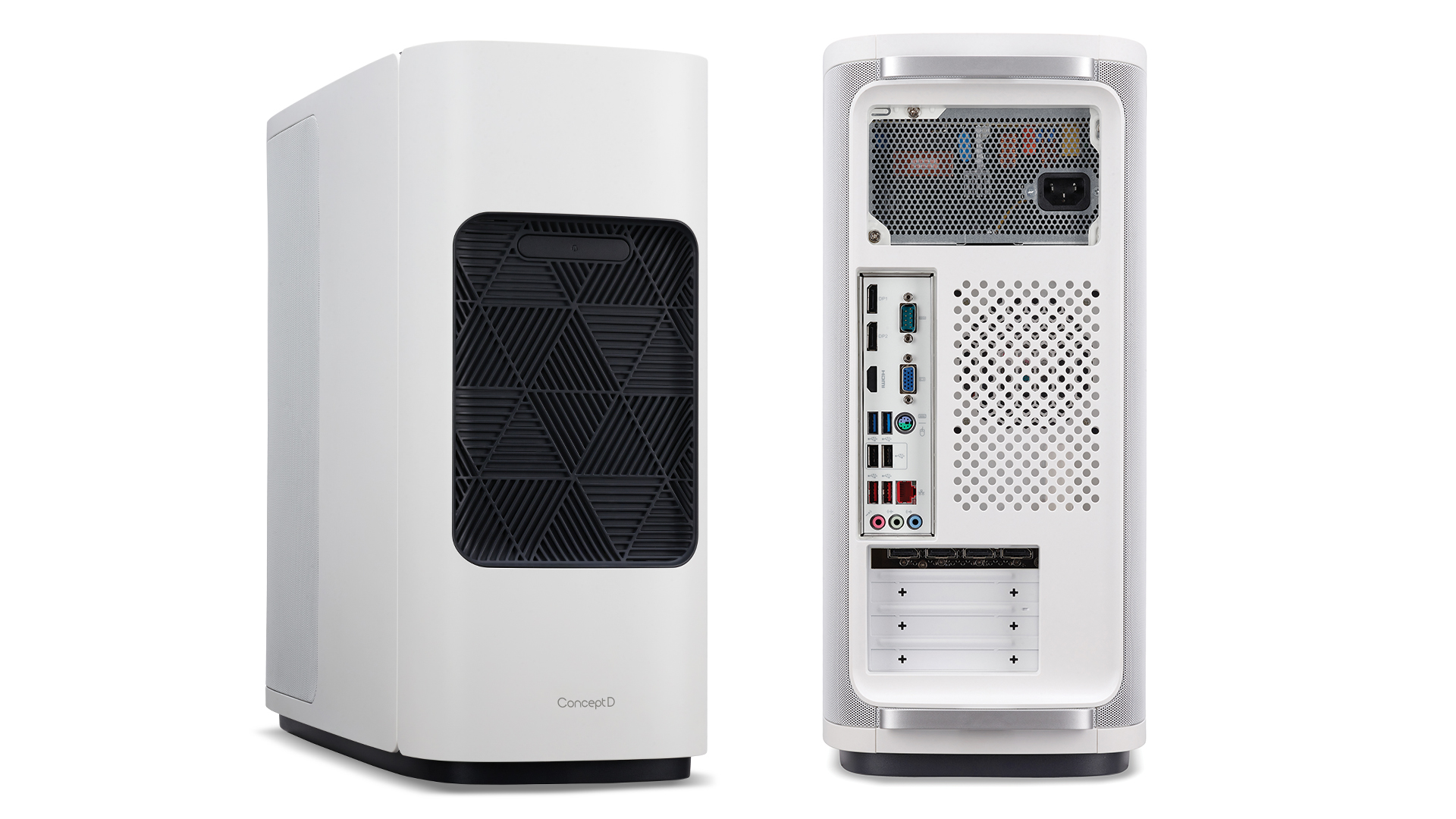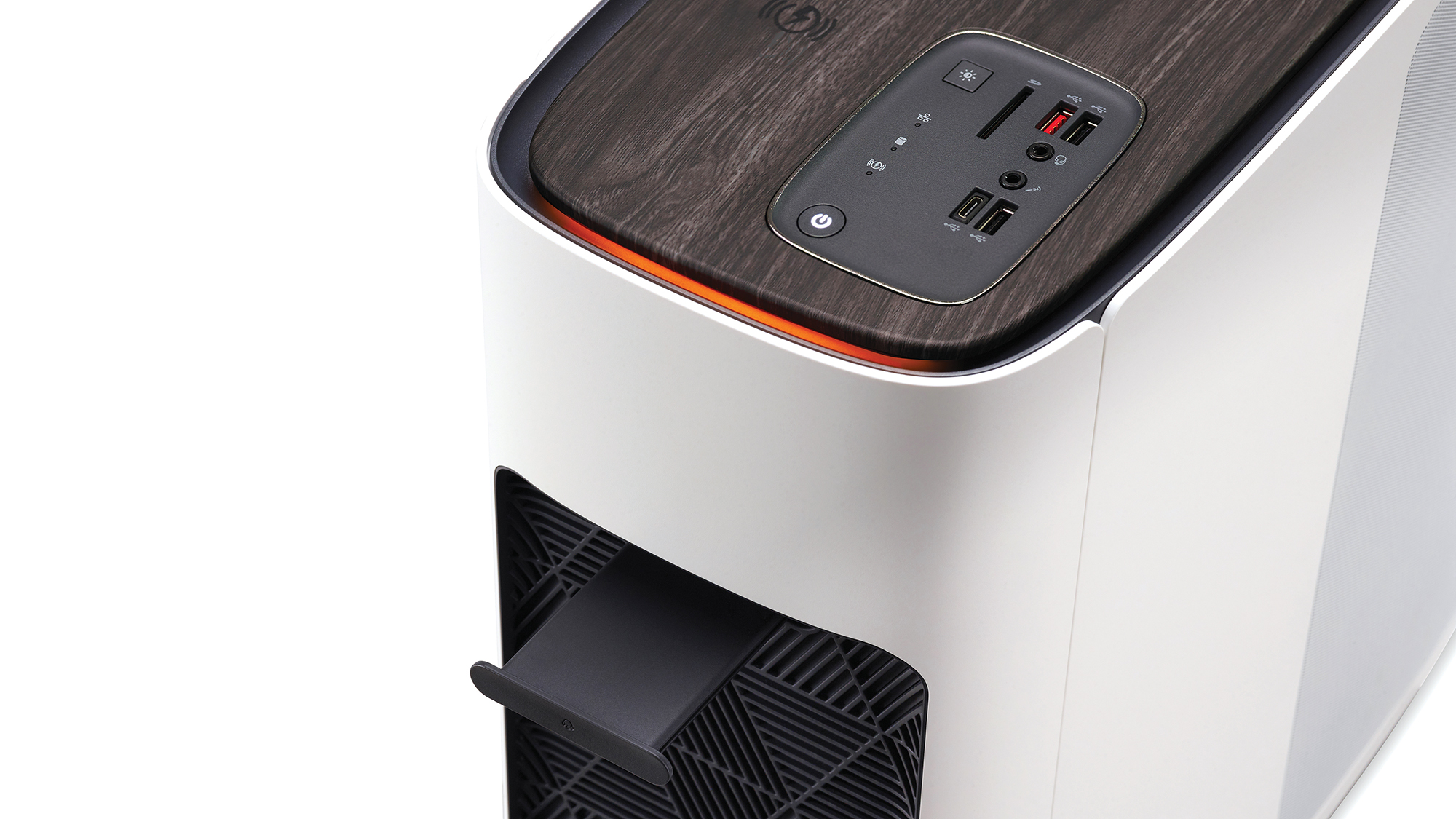Acer ConceptD 700 review: Stylish and well-specified
A workstation that’s whisper-quiet in everyday use, even if it’s outgunned by rivals

Recommended
-
+
Plenty of useful ports
-
+
Perfect for demanding tasks
-
+
Two quiet 80mm fans
-
-
Unsuitable for easy upgrades

They may be targeted at a similar type of buyer, but the ConceptD 700 couldn’t look more different from the Scan 3XS GWP-ME N1-32T. This system has enough style to sit on a design agency’s front desk; there’s even a dark wood effect on the top, with Acer hoping that you might just stretch for an accompanying ConceptD monitor such as the CP5271UV.
The pair certainly look well-matched and if you want to commit to the look, then Acer also plans to sell an all-white ConceptD keyboard and mouse. But it would be wrong to focus too much on this machine’s styling, because its real strength lies inside.
First, the Quadro RTX 4000 graphics card, which accounts for almost a third of the ConceptD’s price. This is made to look anaemic by the Quadro RTX A6000 in the Scan, in part because it’s based on Nvidia’s last-generation Turing architecture rather than Ampere, but it packs plenty of impressive stats nonetheless: 2,304 CUDA cores, 36 RT cores, 288 Tensor cores, and a peak memory bandwidth of 415GB/sec.
Then comes the eight-core, 16-thread Intel Xeon E-2288G CPU, a chip designed for parallel processing. With a 3.7GHz base frequency and Turbo Boost capability of 5GHz, it was no surprise to see this PC break the 300 barrier in our benchmarks. That’s an excellent score for an eight-core chip, although it helps that Acer provides 64GB of ECC memory to aid in the multitasking segment of the benchmarks.
With a speedy 1TB NVMe M.2 SSD in place, it blazed through our sequential read and write tests with rates of 3,106MB/sec and 2,602MB/sec respectively. You have everything you need to churn through demanding tasks.
Acer has video editing, 3D visualisation, and 3D modelling in its sights, and Specviewperf 13 certainly showcased its CAD abilities: a score of 163 in the SolidWorks test isn’t far behind the 196 of the Scan. Its Maya result was also strong, with 266 versus 416 for the Scan. SPECviewperf 2020 emphasised this workstation’s appeal to 3D animators, with 291 in the updated Maya.

Sticking with SPECviewperf 2020, but switching our attention to other tests, a gulf emerges. Take the updated 3ds Max test, where the Scan powered to 195 compared to 89 for the Acer. Or the energy-03 viewset, based on OpendTect (seismic visualisation software), where the Scan scored a groundbreaking 130 to the rather more sedate 98 of its workstation rival. In almost all the other tests, the Scan scored two times or even three times higher.
One advantage of the Quadro RTX 4000 over the far beefier A6000 is its power consumption, with the ConceptD consuming around 35W in idle. At peak it hits 332W, but it’s only when under such load that you notice the fans; most of the time they’re barely noticeable, with quiet 80mm fans at the front and rear, along with a 90mm fan atop the CPU’s heat sink.
To discover these, you have to go through the rigmarole of taking off the case – this involves removing six crosshead screws and a good deal of cursing. The main reason for going through such pain is to expand the storage, with one 3.5in bay vacant above the secondary (and rather stingy) pre-fitted 1TB Seagate hard disk. There’s enough space within the case to add more 2.5in SSDs, but no ready-made cages or holders to slip them into; you’ll need to fashion your own or leave them lying loose. Also note that while four SATA connectors sit empty on the motherboard, it only has the one M.2 slot and that, of course, is already full.
Acer saves money by splitting the 64GB of RAM across all four DIMM sockets, so upgrades aren’t possible without disposing of at least two DIMMs. It’s also a pain to access the Wi-Fi 5 module if you want to upgrade it to Wi-Fi 6, so you may find it easier simply to fill one of the three PCIe slots that sit empty.
All this makes the ConceptD 700 feel like a machine meant to be kept in its pristine state rather than fiddled with. It’s very different in character to the Scan, which is designed for easy upgrades. Still, Acer throws in nice extras to sweeten the deal. First is a Qi wireless charger built into the top of the case, right next to a collection of useful ports: three USB-A 3.1, including a sleep-and-charge port, plus a full-size SD card slot. Acer also includes 3.5mm jacks for a mic and headphone, but the surprise inclusion is a headphone holder that pops out from the front.
These are all excellent bonus features, but what earns this workstation its Recommended award is the amount of power hidden inside such an attractive, quiet shell. If you’re used to power-hungry, fan-fuelled workstations – much like the Scan – then sitting next to the Acer ConceptD 700 all day will be a pleasure. It may not be as fast as that beast of a workstation, but it still delivers a punch in several workloads.
Acer ConceptD 700 specifications
| Processor | Eight-core 3.7GHz Intel Xeon E-2288G CPU |
| Expansion slots | 4 |
| RAM | 64GB 2,666MHz DDR4 SDRAM |
| GPU | Nvidia Quadro RTX 4000 graphics with 8GB GDDR6 memory |
| SSD | 1TB Western Digital SN730 NVMe M.2 SSD |
| Secondary drives | 1TB Seagate Barracuda 3.5in 7,200rpm hard disk |
| Optical drives | N/A |
| Dimensions (WDH) | 204 x 476 x 439mm (WDH) |
| Operating system | Windows 10 Pro 64-bit |
| Warranty (parts & labour unless stated) | 3yr RTB warranty |
Get the ITPro daily newsletter
Sign up today and you will receive a free copy of our Future Focus 2025 report - the leading guidance on AI, cybersecurity and other IT challenges as per 700+ senior executives
Tim Danton is editor-in-chief of PC Pro, the UK's biggest selling IT monthly magazine. He specialises in reviews of laptops, desktop PCs and monitors, and is also author of a book called The Computers That Made Britain.
You can contact Tim directly at editor@pcpro.co.uk.
-
 Nvidia braces for a $5.5 billion hit as tariffs reach the semiconductor industry
Nvidia braces for a $5.5 billion hit as tariffs reach the semiconductor industryNews The chipmaker says its H20 chips need a special license as its share price plummets
By Bobby Hellard Published
-
 Business leaders are having a crisis of confidence over data literacy
Business leaders are having a crisis of confidence over data literacyNews A Salesforce survey reveals business leaders don't trust their data, or their ability to make the most of it
By Emma Woollacott Published
-
 MITRE CVE program handed last minute reprieve amid funding lapse concerns
MITRE CVE program handed last minute reprieve amid funding lapse concernsNews The MITRE Corporation's Common Vulnerabilities and Exposures (CVEs) database has been handed a last minute reprieve amid concerns over funding.
By Rory Bathgate Last updated